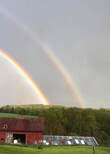CONSERVATION CORNER
A weekly blog for all things conservation
 Farming really is the good life. Anyone that has had a hand in it knows this. It has taught me money management, time management, long days, hard work, respect for both humans and animals alike, and where things really come from; along with realities of life and death as animals are born or animals pass away as time marches on, to learning how to survive off the land if I really had to. There is no better place to raise a child. They come out as respectful, hard workers. Most bosses love to hire people that have come from a farm. Occasionally, we run into some “outsiders” that come rolling in from parts unknown and they are going to plant their flag in the ground and get started on their own little piece of heaven. It looks so heavenly from the outside, and they want to experience it. I think that is a great idea. It really is heavenly. However, this is a really hard transition. It may look easy and lovely from the outside, but getting into it and surviving it can be a different story (see the 3rd sentence of the article).
Farming has never been for the faint of heart, and you are going to need a lot of money and/or capital to do it. You are going to need a lot of perseverance. And you are probably going to need to be willing to work for little to nothing. Some make ends meet, and some do not, but few if any really make what most people would consider a “comfortable” life with it. I think that a lot of people new to “trying” farming find that out the hard way. It may look good from the outside, but it is not the life most are used to. There are also more and more ex-dairy farmers in the area that are now trying their hand at beef production. They know it is a good life, and it is sometimes the only one they know, so they keep plodding along. The problem that they are eventually running into is that everything that they need to keep plodding along is getting EXREMELY costly. I have had this discussion a number of times just in the last week. Want to raise beef cows? You need at least 2 acres/animal to do it. Other animals need less, but still need room to roam. Then, because you feed them, guess what else you have? Manure. Depending on the species, maybe lots of it. Back in the day, if you had horses or a few beef cows you went out an bought a $1500 manure spreader and a $5,000 tractor and you made it work. They needed lots of fixing, but you could do it, or find someone who could. Nowadays, things just keep getting bigger and bigger and more and more expensive. You don’t need to buy a new manure spreader, but if you do, it could be $60,000. Maybe you could find a decent used one for $15,000, but good luck. And you need a tractor to pull it- another $20,000 plus for a really old, but serviceable one. If you want something besides the bare bones, or you are not a mechanic, figure at least $60,000 for the two. It doesn’t take long before those few beef cows, or maybe other animals, are costing you a lot of money. (And yes, you do need to take care of the manure responsibly). There are a lot of people in this pinch right now. Their old, tired equipment from the dairy farm is wearing out and when you go to replace it, it is nearly impossible. Because of the way commercial farming is going, things just get bigger and bigger (and more and more expensive). We still haven’t covered the cost of haying equipment. Again, it used to be that you could buy smaller, older equipment and make it work. Not anymore. I don’t know where this is going, but it has to be less and less people living The Good Life. We just can’t afford to. it will be a shame as it is “the best place to raise the next generation”.
0 Comments
Leave a Reply. |
AuthorsVarious staff at the Bradford County Conservation District Archives
July 2024
Categories
All
|
|
Bradford County Conservation District
Stoll Natural Resource Center 200 Lake Road, Suite E | Towanda PA 18848 Phone: (570)-485-3144 |
